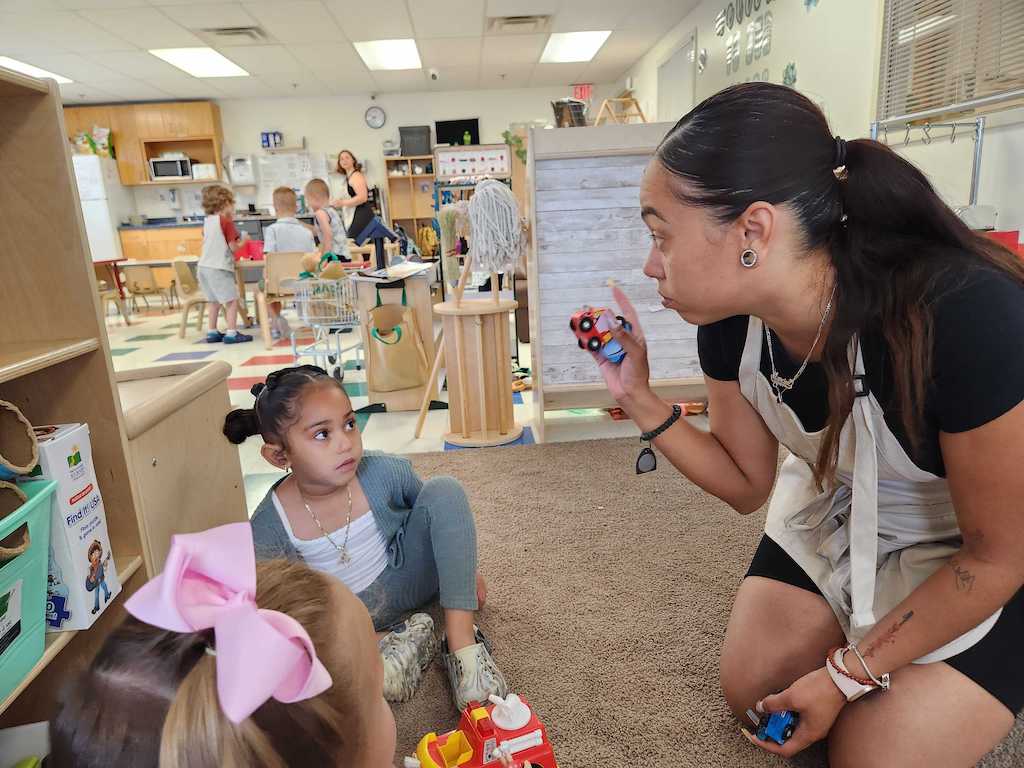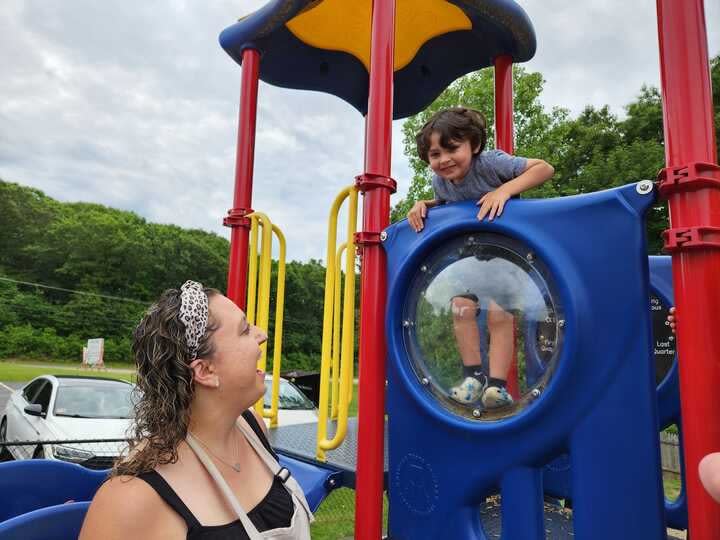For child care workers, state aid for their own kids’ care is ‘life-changing’

- Oops!Something went wrong.Please try again later.
Child care worker Marci Then helps her daughter, Mila, 4, put away toys to get ready for circle time at the Little Learners Academy in Smithfield, R.I. A state program for child care workers subsidizes Mila’s tuition. A handful of other states have similar programs, which advocates say has beneficial ripple effects through the state economy. (Photo by Elaine S. Povich/Stateline)
SMITHFIELD, R.I. — Child care worker Marci Then, 32, looked over at two 4-year-olds in her care who were tussling over a toy plate in a model kitchen set. “Are we sharing?” she gently asked them. They both let go.
Then works at Little Learners Academy child care center near Providence, Rhode Island. Her daughter, Mila, 4, is enrolled there, so Then is able to keep a watchful eye on her in addition to about a dozen other 4-year-olds. Mila calls her mother “Miss Marci” at school, but “Mom” at home.
Most of the time, Mila is in another room with a different worker at the center, adhering to rules that don’t allow parent caregivers to watch their own children in a licensed setting. But for today, Mila is around her mom for a bit to show a reporter around.
Mila proudly chirps her age, then helps put toys away so the kids can quietly gather for circle time.
Then said that without help she would not have been able to afford the $315 a week for Mila to come to Little Learners. But she is taking advantage of a one-year state pilot program that authorizes the use of federal funds to pay for care for the children of early education workers.
“It’s been life-changing for me,” said Then, a single mom who is also responsible for a disabled young adult whom she adopted. Without it, “I’d have to rearrange my life.”
In 2022, Kentucky lawmakers changed the employer child care assistance program to specifically include child care workers at all income levels who work at least 20 hours a week. Other states, including Rhode Island, have since launched programs modeled after the one in Kentucky. The Kentucky program was to end Sept. 30, but Stephanie French, spokesperson for the state’s Cabinet for Health and Family Services, wrote in an email that the state will be using a combination of federal and state funding to continue the program.
At least half a dozen states, including Iowa, now have similar programs or are considering legislation to start them, according to EdSurge, a news site that covers education issues.
Supporters, including Republicans and Democrats, see retaining child care employees as a benefit not only to the workers and the centers facing worker shortages, but also to the states’ economies. For many people, the lack of affordable child care is a barrier to joining the workforce.
Charlene Barbieri, founder and owner of four Little Learners Academy locations in Rhode Island, said in an interview that it is difficult to hire and keep qualified employees. The child care subsidy program helps, she said.
“Early learning here is very expensive as we know, right?” Barbieri said. “So any supplemental programs, monetary or otherwise, are exceptionally beneficial.
“We have had many teachers come to us to say that if this program wasn’t here, we could not afford to send our children to child care and still help our families by bringing in additional income,” she said.
Rhode Island lawmakers added the child care subsidy to its fiscal 2025 budget this spring, moving the program out of the “pilot” category. Democratic Gov. Dan McKee is expected to sign the budget this week.
“It’s a good program, and we’ve seen great results with it,” Rhode Island House Speaker Joseph Shekarchi, a Democrat, said in an interview. “We have a labor shortage across the whole spectrum of our labor market. So, by giving [caregivers] free child care, they’re able to get back in and take care of other kids, which allows more people to enter the workforce.”
Other states besides Iowa that have launched programs or are considering them include Arizona, Colorado, Indiana and Nebraska, according to EdSurge.
The Center for the Study of Child Care Employment, a research center at the University of California, Berkeley, estimated that if every state followed Kentucky’s lead, some 234,000 workers with children under age 6 could benefit.
“We see it as a no-brainer,” said Anna Powell, senior research and policy associate at the center, who co-authored a report on the program. “The educators are parents — why shouldn’t they be at the front of the queue? Every time an educator stays in the field, it benefits many parents.”
Budget challenges
In some states, though, budget woes are challenging lawmakers who want to make their pilot program a permanent one.
Arizona had a one-year Education Workforce Scholarship program that assisted child care workers and public school teachers with paying for their own kids’ child care, but that program was funded with federal pandemic dollars and ends June 30. It’s unlikely to be renewed because of state budget shortfalls.
Child care workers who now get that assistance would instead need to apply for aid through the state’s broad child care assistance program. That program, administered by the Arizona Department of Economic Security, is based on income levels, Tasya Peterson, a department spokesperson, wrote in an email to Stateline.
Barbie Prinster, executive director of the Arizona Early Childhood Education Association, a nonprofit that represents child care centers, said 3,541 children were approved for care subsidies under the early educator program this year, about three-quarters of them from families with a child care worker. The rest are from teachers’ families.
She predicted that hundreds of workers may have to quit if the subsidy isn’t renewed.
“I think providers are employing more moms that have young children because of this subsidy,” she said.
In Nebraska, state Sen. John Fredrickson, a Democrat and the dad of a 5-year-old son, introduced a bill this session that would have granted no-cost child care to employees of state-licensed child care programs, whether in-home care or at centers, who work at least 20 hours a week.
He estimated the potential subsidy, which he modeled on Kentucky’s idea, could have brought in 2,175 parent-providers. If each worker cared for eight children, there would be 16,000 children receiving care, and at least that many parents working, he estimated.
Fredrickson said the initial fiscal estimate for the bill was about $20 million, which proved to be a heavy lift, so he halved it to $10 million. But even that proved to be too much, he said, and the effort failed. He plans to reintroduce his bill next year.
Iowa Gov. Kim Reynolds, a Republican, approved a bill May 1 extending a child care subsidy pilot program for early childhood caretakers and educators, regardless of income, for two years at a cost of $10.2 million using the state’s Childcare Development Fund.
The Iowa Legislature passed House File 2958 with near-unanimous support. It extends Iowa’s child care workforce pilot program to June 30, 2025.
Colorado agreed to continue a program for child care providers with children ages 6 weeks to 13 years old, giving them full child care benefits, regardless of the employee’s income.
And Indiana agreed to study the issue of child caregiver and early educator compensation.
‘Good for Rhode Island’
Sitting together in a hearing room just off the Rhode Island House chamber earlier this month, Democratic state Reps. Mary Ann Shallcross Smith and Grace Diaz said they understand the issue of caring for children firsthand. Both are mothers, though their children are grown now, and both are experienced child care center owners.
Shallcross Smith remembers putting up flyers in the local drug store, advertising her in-home care. She now owns 15 centers. When the issue of paying child care workers for their own kids’ tuition came up this year, she was all for it, and went to House Speaker Shekarchi with her arguments.
“No. 1, it’s good for Rhode Island,” she said, adding that it’s also good for business.
Diaz, a mother of five, said she, too, talked to the speaker. But perhaps the biggest driver in getting the program into the state budget, she recalled, was the day that they brought a bunch of little kids from various child care settings to the Capitol to be a living example of the need.
“When they saw the little kids at the State House, they all wanted a picture,” Diaz said.
Back on the Little Learners playground, care worker Kayla Champagne, 39, of Lincoln, Rhode Island, smiled up at her 3-year-old son, Jaxson, who peeked over the top of a climbing structure. Champagne, who has three other children ages 18, 14 and 8, is relieved that she can take advantage of a program that helps her pay for Jaxson’s care.
She used to work at another day care place but could only afford to send Jaxson there a few days a week, she said. At Little Learners, staff helped her apply for the state subsidy.
“That’s one of the reasons I left my other child care to come here,” she said. “Now I can work full time while having four kids.”
Rhode Island Current reporter Nancy Lavin contributed to this report.
This story was originally published by Stateline, which is part of States Newsroom, a nonprofit news network supported by grants and a coalition of donors as a 501c(3) public charity. Stateline maintains editorial independence. Contact Editor Scott S. Greenberger for questions: info@stateline.org. Follow Stateline on Facebook and X.
The post For child care workers, state aid for their own kids’ care is ‘life-changing’ appeared first on Iowa Capital Dispatch.



